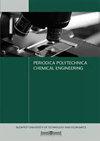Effect of Operating Parameters on Agricultural Biomass Mixture Pyrolysis Process in a Batch Reactor
IF 1.8
4区 工程技术
Q3 ENGINEERING, CHEMICAL
引用次数: 0
Abstract
Many phenomena affect devolatilization of biomass particles, including mass and heat transfer, chemical reactions and physical transformation. Mathematical models that are capable to describe pyrolysis phenomena can greatly assist the large-scale development and optimization of pyrolysis processes, but to be implemented into large-scale simulation the models need to be simplified at a certain degree. In the present study, an existing mathematical model is used to describe the pyrolysis of a single particle of biomass. It couples the heat transfer equations with the chemical kinetics equations. The common Euler explicit method is used for solving the heat transfer equation and the two-step pyrolysis kinetics equations. The model equation is solved for a sphere particle with a radius of 0.001 m and temperature ranging from 300 to 923 K. An original numerical model for the pyrolysis of agricultural biomass mixture is proposed and relevant equations solved using original program realized in MATLAB. Simplified particle model was validated with the experimental data in a non-isothermal pyrolysis reactor. The sample was heated in the temperature range of 300–923 K at average heating rates of 21, 30 and 54 K/min. The model results showed reasonable agreement with experiments. The difference (between the experimental and model results) is slightly more prominent with decreasing heating rate (21 and 30 K/min), but model results are in much better agreement with the experimental date for higher heating rate (54 K/min). It is demonstrated that a constitutive equation can be used to express devolatilization rate for higher heating rates.操作参数对间歇式反应器中农业生物质混合热解过程的影响
影响生物质颗粒脱挥发的现象有很多,包括传质传热、化学反应和物理转化。能够描述热解现象的数学模型对热解过程的大规模开发和优化有很大的帮助,但要实现大规模模拟,模型需要进行一定程度的简化。在本研究中,使用现有的数学模型来描述单个生物质颗粒的热解过程。它将传热方程与化学动力学方程耦合在一起。采用通用的欧拉显式法求解传热方程和两步热解动力学方程。求解了半径为0.001 m、温度为300 ~ 923 K的球形粒子的模型方程。提出了农业生物质混合物热解的原始数值模型,并利用MATLAB实现了原始程序求解相关方程。用非等温热解反应器的实验数据对简化颗粒模型进行了验证。样品在300-923 K的温度范围内加热,平均加热速率为21、30和54 K/min。模型计算结果与实验结果吻合较好。随着升温速率的降低(21 K/min和30 K/min),(实验和模型结果之间的差异)略显突出,但当升温速率较高(54 K/min)时,模型结果与实验数据更加吻合。结果表明,在较高的升温速率下,可以用本构方程来表示脱挥发速率。
本文章由计算机程序翻译,如有差异,请以英文原文为准。
求助全文
约1分钟内获得全文
求助全文
来源期刊

Periodica Polytechnica Chemical Engineering
ENGINEERING, CHEMICAL-
CiteScore
3.10
自引率
7.70%
发文量
44
审稿时长
>12 weeks
期刊介绍:
The main scope of the journal is to publish original research articles in the wide field of chemical engineering including environmental and bioengineering.
 求助内容:
求助内容: 应助结果提醒方式:
应助结果提醒方式:


